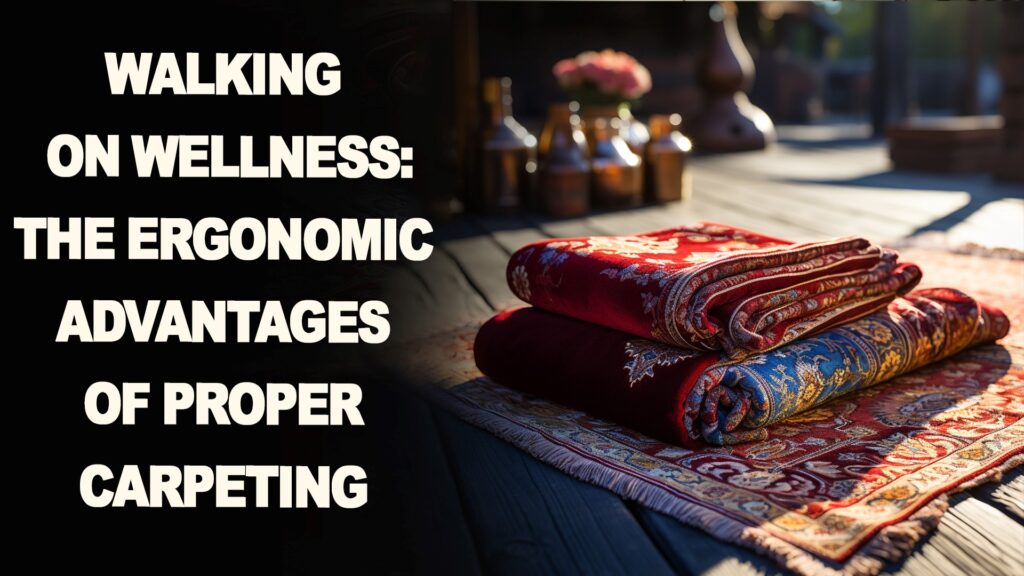
Introduction to Ergonomic Carpeting
When we think about ergonomics, the mind typically conjures images of comfortable office chairs, adjustable desks, and equipment designed to prevent repetitive strain injuries. However, the concept of ergonomics extends well beyond the office and into the design of our living spaces. Among these considerations, the flooring we choose plays a pivotal role, with carpeting standing out as a particularly ergonomic option. Ergonomics, in the context of flooring, refers to designing and arranging spaces so that they fit the people who use them. Carpeting, with its cushioning effect, can be tailored to support human health and well-being in multiple ways.
Ergonomic carpeting is about creating environments that support our natural movements and reduce the strain on our bodies. As we walk, stand, or even sit on the floor, the surfaces beneath us can affect our posture, comfort, and long-term health. Carpeting, by its very nature, provides a softer impact for our feet and joints, thus offering a solution to the hard surfaces that dominate many modern interiors.
The Science Behind Carpet Ergonomics
Carpeting can transform the ergonomics of any environment by providing a supportive surface that helps to distribute weight and alleviate strain on the body. But how exactly does this work?
Impact Absorption and Joint Health
Our joints are designed to move and bear weight, but hard surfaces can cause an increased impact on the knees, hips, and spine. Carpets act as a buffer against this impact. The pile of a carpet compresses under weight, absorbing some of the forces that would otherwise directly stress the joints. This cushioning can be especially beneficial for individuals suffering from arthritis or other joint-related issues.
Carpet Pile and Its Effects on Posture and Gait
The height and density of a carpet’s pile also contribute to its ergonomic properties. A carpet that is too soft may impede movement, causing more strain as the feet sink in. Conversely, a carpet that is too firm may not provide adequate cushioning. A balance is essential for proper posture and natural gait.
Studies and Research on Carpet Ergonomics
Numerous studies have compared the physical effects of walking on hard versus carpeted surfaces. Findings suggest that carpets can reduce the stress on the body, with participants reporting less fatigue when walking on carpeted surfaces. These studies highlight the long-term benefits of choosing carpeting for spaces where people will spend significant time on their feet.
Choosing the Right Carpet for Ergonomic Benefits
The market offers a wide array of carpet options, each with its own set of ergonomic benefits. Making an informed choice requires understanding the differences in materials and construction.
Materials Matter: Comparing Synthetic vs. Natural Fibers
Synthetic fibers, such as nylon and polyester, are known for their durability and stain resistance, while natural fibers like wool have a luxurious feel and natural elasticity that can be more comfortable underfoot. However, the ergonomic benefits go beyond comfort. Wool, for instance, has natural insulating properties that can keep a space warmer, possibly alleviating discomfort from cold floors.
Carpet Density and Pile Height
Density refers to how closely knit the fibers of the carpet are, which affects how easily the carpet compresses under weight. A denser carpet generally offers more support, which can be crucial for ergonomic benefits. Pile height, on the other hand, relates to the length of the carpet fibers. Here, personal preference and the intended use of the room come into play. For example, a low, dense pile may be best for areas where wheelchairs or walkers need to move smoothly.
Carpet Padding: The Unsung Hero of Ergonomics
While the carpet itself is important, the padding underneath can greatly enhance its ergonomic benefits.
The Role of Underlay in Ergonomic Carpeting
The underlay, or padding, acts as a shock absorber, complementing the carpet’s natural cushioning properties. High-quality padding can improve the feel of the carpet, reduce noise, and even extend the life of the carpet by preventing the pile from crushing.
Types of Padding and Their Ergonomic Qualities
Different types of padding, such as foam, rubber, and fiber, each have their attributes. Memory foam padding, for example, provides excellent pressure relief and is beneficial in areas where people may stand for long periods, such as in front of a kitchen sink.
Ergonomic Design and Carpet Installation

The way a carpet is installed can have a significant impact on its ergonomic properties. Tension, fit, and securement are all critical factors to consider during the installation process.
Proper Tension to Prevent Tripping Hazards
Carpet that is not properly stretched and secured can lead to bunching or lifting, which are not just unsightly but can also be tripping hazards. Ensuring that the carpet is tightly affixed to the floor prevents these risks and also contributes to the even wear of the carpet, preserving its ergonomic benefits over time.
Seamless Transitions for Safety and Accessibility
In spaces where carpet meets other types of flooring, the transitions must be seamless to prevent tripping and allow for easy movement, especially for those using mobility aids. Reducers, which are transition strips that level out the difference between surfaces, are an ergonomic solution that can safely bridge the gap between a carpeted area and hard flooring.
Considering Carpet Tiles for Flexible Ergonomic Design
Carpet tiles are another option that can offer ergonomic benefits. They allow for targeted cushioning and easy replacement of high-traffic areas, maintaining the overall comfort and support of the carpeted space without the need to replace the entire flooring.
Maintaining an Ergonomic Carpet
To retain the ergonomic advantages of carpeting, regular maintenance is crucial. Cleaning, repair, and even the way furniture is placed on a carpet can influence its ergonomic properties.
The Importance of Regular Cleaning for Carpet Longevity
Dirt and debris can break down carpet fibers over time, reducing their cushioning ability. Regular vacuuming and periodic deep cleaning can extend the life of the carpet and maintain its ergonomic benefits. Moreover, a clean carpet improves indoor air quality, which is an essential aspect of an ergonomically healthy environment.
Repairing Carpets to Preserve Ergonomic Features
Snags, tears, or separations in the seams of a carpet can compromise its ergonomic integrity. Prompt repair is necessary to prevent further damage and to keep the surface even and supportive.
Furniture Placement and Movement on Carpeting
Heavy furniture can compress carpet and padding, leading to uneven surfaces. Using furniture coasters or moving furniture periodically can help prevent these pressure points, preserving the uniform cushioning of the carpet.
Ergonomic Benefits Beyond Physical Comfort
Ergonomic carpeting offers advantages that extend beyond the physical comfort and support for the body; it can also contribute to psychological well-being and productivity.
Acoustic Comfort: The Sound-Absorbing Qualities of Carpet
Carpeting can significantly reduce noise levels in a space, leading to a quieter, more comfortable environment that is conducive to concentration and relaxation. This acoustic comfort is particularly beneficial in multi-story buildings, where foot traffic from upper levels can be disruptive.
Thermal Comfort: Insulation and Warmth
The insulating properties of carpet help maintain a room’s temperature, contributing to thermal comfort. A warmer floor during cold seasons can make a space feel more welcoming and reduce the need for higher thermostat settings.
Visual and Aesthetic Comfort
A well-chosen carpet can enhance the aesthetic of a room, contributing to a sense of well-being. Colors and patterns that are pleasing to the eye can have a calming effect and make a space more inviting.
Future Trends in Ergonomic Carpet Design
The future of ergonomic carpet design is promising, with innovations that continue to improve the health and comfort benefits of carpeting.
Eco-Friendly Materials and Manufacturing Processes
Sustainable materials that are non-toxic and have low environmental impact are increasingly in demand. Carpets made from recycled or plant-based fibers are becoming more popular, offering both ergonomic and ecological benefits.
Smart Carpets: Technology Meets Ergonomics
Advancements in technology have led to the development of smart carpets embedded with sensors that can track movement and even monitor health indicators. These innovations have the potential to revolutionize how we interact with our environments, providing data that can inform ergonomic improvements.
Customization for Individual Needs
Customizable carpet options, which allow for varying levels of cushioning and support tailored to individual needs, are becoming more available. This personalization is the next step in ergonomic flooring, ensuring that the benefits of carpeting are accessible to everyone.
In sum, proper carpeting is not just a matter of aesthetics or comfort—it is a significant ergonomic consideration that can affect our health and well-being in profound ways. From the absorption of impact to the provision of insulation and noise reduction, carpeting contributes to an environment that supports both physical and mental health. As the design of work and living spaces continues to evolve, the importance of ergonomic carpeting is becoming increasingly recognized. By choosing the right materials, ensuring proper installation, and maintaining the carpet over time, we can make the most of these benefits and truly walk on wellness.